Tijdens de derby De Stukkenjagers B – De Stukkenjagers C was de partij aan het topbord meeslepend. Tsz Keung Wong neemt ‘m onder de loep.
I quit the Avondcompetitie this year because of my unsuccessful results last year (only one win, if I remember correctly). Nevertheless, I am the substitute in the battle for SJ C against SJ B yesterday night. I was asked to share the final position with the unexpected mate in 2 with the pawn, but I might just as well show and annotated the game from the middle game. To those who are only interested in the David and Goliath (=pawn vs king) mate, please go to the final diagram.
Tsz Keung Wong (SJ C) – Marieke Sarton (SJ B)
1. c4 e5 2. Nc3 Nc6 3. g3 Nf6 4. Bg2 Bb4 5. e3 O-O 6. Nge2 Bxc3 7. Nxc3 d6 8. O-O Be6 9. b3 Qd7 10. Nd5 Bxd5 11. cxd5 Ne7 12. e4
What should be the plan here for Black? From my perspective, I need to solve the problem of the c1-bishop, the weakness on e4 and the bishop g2. In a way, I need a lot of time to reach the ideal position where my dark bishop is on b2, the white bishop on h3 and pushing my d-pawn striking the center.
So I think, for Black, playing c6, challenging the center, is needed right now.
12… h6
Protecting g5 in case of White playing d4-Bg5-Bxf6, I guess.
- Bb2 Nh7 14. d4
The plan I aimed for.
14… f6
Probably the best move in the position even though it weakens the white squares and the diagonal, so the e6-square will be a good place for my bishop or at least it should stay on h3-c8 diagonal to control the white squares and increase my control of the open c-file.
Another thing I noticed was that the knight on h7 literally has no squares, and this explains my next prophylactic move.
15. h4
15… c6
Yes, c6 is the right move here, but playing it a few moves earlier would be a lot better. Comparing this diagram and the first diagram, you would see that the positioning of my pieces has improved, Black weakened the white squares and I reached my goals.
- dxc6 Nxc6 17. d5 Ne7 18. Kh2 f5 19. Bh3 Qe8
What should be the plan for White here?
Alas, I did not see the correct plan here. I played the passive move f3. Marieke suggested the move f4 here, which I strongly agree with! The point of f4 is opening f-file and the a1-h8 diagonal. Then all my pieces will be very happy, particularly the bishops on the open diagonals and the rook on f-file. In the meantime, the black knights are not so well placed.
- f3 g6 21. Qd2 g5 22. Ba3 Qg6 23. Qd3 fxe4 24. Be6+??
I lost two games in the tournament in Goirle at the start of this month against players rated 1300 and 1400 by hanging my queen and missing one-move tactics. The impatience really got to me here, and I can not believe it happened again, despite me trying to play this game as slow as possible. Can you find the winning move here for Black?
I thought with Be6+ I could improve the position of my bishop, and block the queen from protecting the d6-pawn. Neither I nor Marieke did see that Black can simply take the bishop with the queen!
24…Kg7?? 25. Qxe4 Rad8 26. Qxg6+ Kxg6 27. Rac1 Nf6 28. Rfd1 gxh4 29. gxh4 Kh5
Very critical position here, the king seems safe on h5, but it is White who can take control of the squares around Black’s king, this can easily be done by Rg2 (or Rc7-Rg7 if the knight moves away) and box the king. Because of the bishop on e6, it is very difficult for Black to fight for the control of the g-file. This is the reason why both knights should remain their current positions to keep the pressure on d5 and prevent my rook on d1 going to g2. But the more important reason of keeping the pressure on d5 is that the bishop is simply too strong and annoying.
- Rc7
This move is aimed at kicking the knight out and continue with my plan.
30 …Ng6 31. Kg3
I played this move simply to protect the two pawns and open the h-file for the rook to prevent Black from taking the pawn. Also, because I kind of feel that I need to control f4-square. In hindsight, 31. Rg7 would have been the better move.
This position is very difficult to play for Black, both psychologically and practically. I think it deserves a diagram even though 31. Kg3 is not the right move.
31… e4
As Marieke played this move, I was like ‘damn what a move, I probably still need to play a long endgame to win the game’. But then I saw the mating idea: 32. Bg4 Nxg4 33. fxg4#

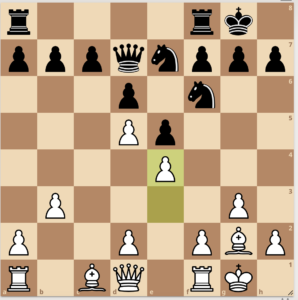
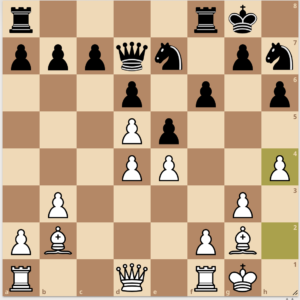
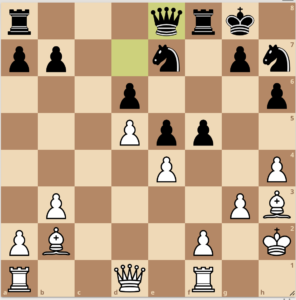
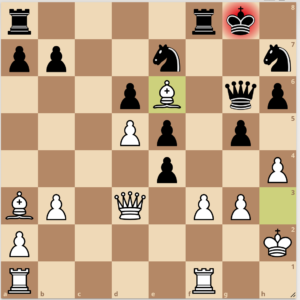
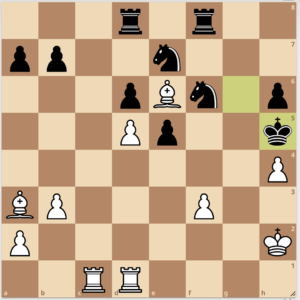

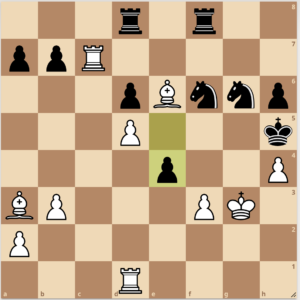
I also found out yesterday that I could have taken your bishop after Be6!